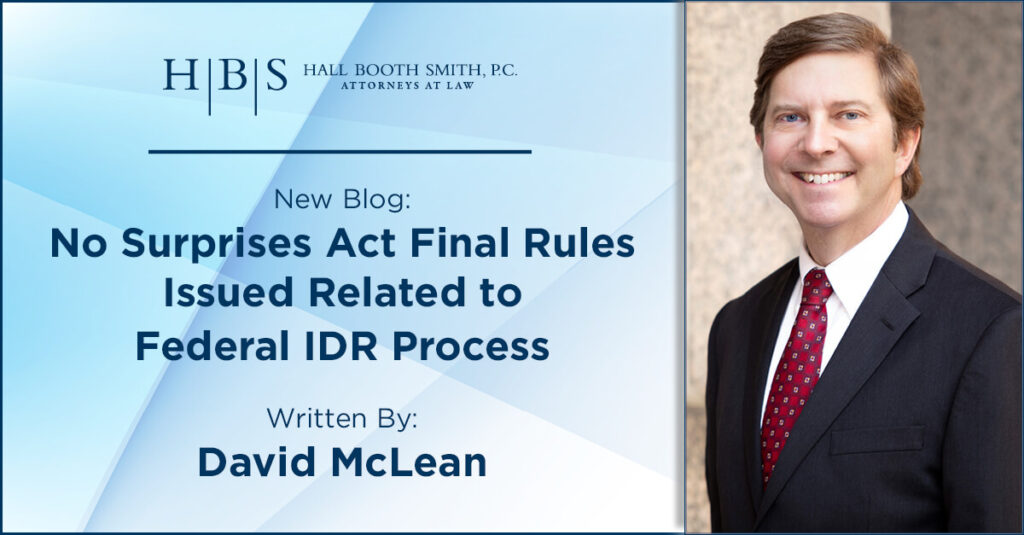
No Surprises Act Final Rules Issued Related to Federal IDR Process

Written by: S. David McLean, Jr.
On August 26, 2022, the long-awaited Requirements Related to Surprise Billing: Final Rules (the “Final Rules”) were published in the Federal Register (87 Fed. Reg. 52618). The No Surprises Act Final Rules are purposefully narrow in scope, finalizing parts of the July 2021 and October 2021 interim final rules (collectively, the “Interim Final Rules”) and addressing provisions that were vacated by the District Court in the Texas Medical Association, et al. v. United States Department of Health and Human Services, et al. (Case No. 6:21-cv-425, E.D. Tex.; “Texas Medical Association”) and Life Net, Inc. v. United States Department of Health and Human Services, et al. (Case No. 6:22-cv-162, E.D. Tex.; “LifeNet”) cases.
The Final Rules will be effective on October 25, 2022. It is unknown what the impact of the publication of the Final Rules will be on other pending but stayed challenges to the Interim Final Rules and whether there may be additional challenges arising from the Final Rules. The Department of Treasury (IRS), Department of Labor (ERISA), and Department of Health and Human Services (CMS) (collectively, the “Departments”) intend to finalize the remaining provisions of the Interim Final Rules after further consideration of comments.
Information to be Shared about the Qualifying Payment Amount
The Departments first address information that must be disclosed about the qualifying payment amount (“QPA”) to address “downcoding” of claims by a plan or issuer. The Final Rules define the term “downcode” to mean the alteration by a plan or issuer of a service code to another service code, or the alteration, addition, or removal by a plan or issuer of a modifier, the changed code, orif a modifier is associated with a lower QPA than the service code or modifier billed by the provider, facility, or provider of air ambulance services.
The Final Rules also provide that if a QPA is based on a downcoded service code or modifier — in addition to the information already required to be provided with an initial payment or notice of denial of payment — a plan or issuer must provide a statement that the service code or modifier billed by the provider, facility, or provider of air ambulance services was downcoded, an explanation of why the claim was downcoded — including a description of which service codes were altered, if any — and which modifiers were altered, added, or removed, if any. Additionally, the amount that would have been the QPA had the service code or modifier not been downcoded must be provided in that statement.
Payment Determinations under the Federal IDR Process
The Final Rules also address payment determinations under the Federal IDR process. The Departments explained in the Preamble that it is, “reasonable to ensure that certified IDR entities consider the QPA, a quantitative figure [which is calculated to meet the credibility standard], and then to consider the additional, likely-qualitative factors, when determining the out-of-network rate- another quantitative figure.”
In light of the Texas Medical Association and LifeNet decisions, the Departments removed the provisions that the District Court vacated and “adopt[ed] standards for making a payment determination that are intended to achieve the statutory aims…” Under the Final Rules, the certified IDR entity is required to first “consider” the QPA. Notably, although the Final Rules do not require the certified IDR entity to select the offer closest to the QPA, the Departments remain of the opinion that it will “often be the case that the QPA represents an appropriate out-of-network rate.”
Since the Departments acknowledged that the “QPA may not account for information specific to a particular item or service,” the certified IDR entity is then required to consider additional information submitted by the parties, provided that the information relates to the party’s offer for the payment amount for the qualified IDR item or service that is the subject of the payment determination and does not include information that the certified IDR entity is prohibited from considering.
The Final Rules further require the certified IDR entity to evaluate whether the additional information that is offered is “credible” and should not give weight to information that is not credible. Credible information is defined as information that upon critical analysis is worthy of belief and is trustworthy. The certified IDR entity is also required to evaluate the additional information and should not give weight to that information if it is “already accounted for in the QPA.”
The Departments did not provide any additional guidance to certified IDR entities in making these determinations. However, the Final Rules do provide five new examples intended to illustrate the consideration of factors when making a payment determination.
The Certified IDR Entity’s Written Decision
Finally, the Departments have finalized standards that require that the certified IDR entity explain in all cases its determination in a written decision provided to the parties and the Departments, in a form and manner which will be specified in separate guidance.
The Final Rules continue to require that the rationale be included in the written decision. The Final Rules also provide that the certified IDR entity’s written decision must include an explanation of its determination, including what information the certified IDR entity determined demonstrated that the offer selected as the out-of-network rate is the offer that best represents the value of the qualified IDR item or service, including the weight given to the QPA and any additional credible information submitted in accordance with the Final Rules.


Leave a comment
You must be logged in to post a comment.